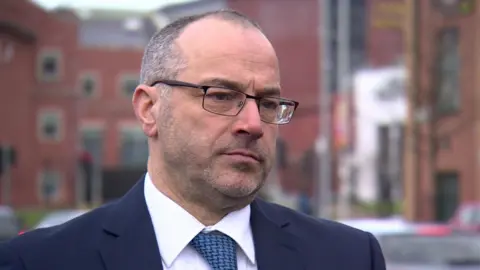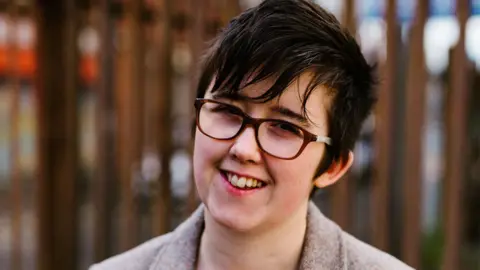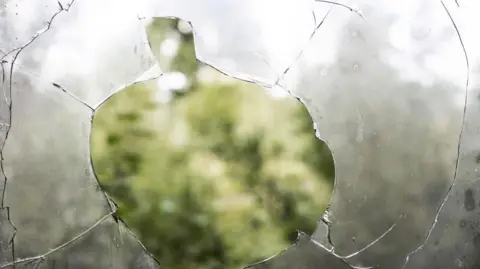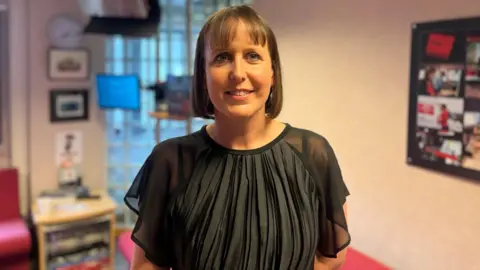More than 70 threats or attacks on journalists in NI since 2019
 BBC
BBCThere have been 71 attacks or threats on journalists in Northern Ireland since 2019, a report by Amnesty International has found.
The report features 26 interviews, including 22 with journalists in which they recounted their experiences of being told they will be shot or stabbed, and threatened with bombs under their car.
It also said that many journalists no longer report threats due to "time consuming processes and lack of action or positive outcome".
Patrick Corrigan, the human rights organisation's Northern Ireland director, said Northern Ireland is the most dangerous place in the UK for journalists.
 PA Media
PA MediaLyra Mckee and Martin O'Hagan
The PSNI said it takes the safety of journalists very seriously and has been involved in developing plans to tackle the issue over the last couple of years.
The report is dedicated to Martin O'Hagan and Lyra McKee, two journalists who were killed in 2001 and 2019 respectively.
Mr O'Hagan, who was a journalist for the Sunday World newspaper, was shot dead by the Loyalist Volunteer Force (LVF) in Lurgan, County Armagh, in 2001.
Lyra McKee died after being struck by a bullet while observing rioting in Creggan in Londonderry in 2019.
Lack of prosecutions
 Getty Images
Getty ImagesThe report said petrol bombs had been thrown at journalists' cars, and pipe bombs left close to their homes.
It added that "several journalists report that they are receiving more threats in recent years than ever before".
These threats were said to be primarily from armed paramilitaries, as well as organised crime groups.
Some journalists told the organisation they had "lost count" of the threats they have received.
The report said since June 2022, only two people have been successfully prosecuted for threats against journalists, none of which were made by paramilitary groups.
It also reported that one media company has spent tens of thousands of pounds on ensuring journalists' homes are protected.
'Press freedom under attack'
Mr Corrigan said threats created "a climate of fear that many assumed was consigned to history".
"When journalists are under attack, press freedom is under attack," he added.
National Union of Journalists (NUJ) assistant general secretary Seamus Dooley said that in "what is supposed to be normalised society, post the peace process, journalists are living in fear and behind high-security measures.
"That really is not the sign of a normal functioning democracy."
Among the journalists interviewed, was Belfast Telegraph crime correspondent Allison Morris, who police visited on nine occasions between December 2023 and October 2024 to deliver threats from paramilitary or criminal groups.
Ms Morris told the authors of the report: "I'm convinced someone's going to kill me at some point.
"Most of the time, I pretend that the threats don't annoy me, but clearly, they do."
Sunday World Northern Editor Richard Sullivan said threats included being "given 48 hours to get out of the country or I'd be shot".
Photographer Kevin Scott, from the Belfast Telegraph, said he has three cars and alternates his use of them for safety reasons.
Ch Supt Sam Donaldson said: "The Police Service of Northern Ireland has received the report from Amnesty International and will take time to consider the contents and recommendations."

Kathryn Torney, one of the authors of the report, told BBC Radio Ulster's Good Morning Ulster programme that, of the 22 journalists they spoke to for the report, they told them that they were receiving "regular death threats" because of their journalism.
She added that the report is not the full picture because "we haven't spoken to every journalist in Northern Ireland".
She also said that journalists are not eligible for the government's home protection scheme and "in some cases, if they are lucky, their employers will pay" for security at their homes.
Ms Torney added there was a "genuine commitment" from the PSNI to protect journalists.
'Journalists do not have to tolerate threats and crimes'
The Police Service of Northern Ireland has developed a joint strategy and joint plan with the NUJ and with local editors.
It has appointed two journalist safety officers, established an internal journalist safety group, implemented screening arrangements within its contact management centre and "ensured that reports of threats and crimes by journalists are investigated by detectives".
"The police service has also arranged a number online seminars for local media around internet and personal safety," said Ch Supt Sam Donaldson.
"Journalists do not have to tolerate threats and crimes as part of their role," he added.
Report recommendations
The report makes a number of recommendations including:
- asking the justice minister to establish and chair a new Media Safety Group, with representatives from the PSNI, Public Prosecution Service, media organisations and the NUJ, to deliver a new journalist safety strategy
- urging the PSNI to review its procedural response to threats and attacks against journalists and conduct investigations capable of leading to successful prosecutions
- calling on the PSNI to produce new guidance and training for officers on the protection of journalists during public disorder
- urging the Northern Ireland Office and Department of Justice to ensure at-risk journalists can access the Home Protection Scheme
- calling on the UK government to establish an independent public inquiry into the murder of Martin O'Hagan "if the expected police ombudsman's investigation finds serious failings or wrongdoing by the police"
The PSNI has said that if any journalist needs advice in relation to an incident, threat or crime connected to their role, they should contact 101 and speak to one of the journalist safety officers.
